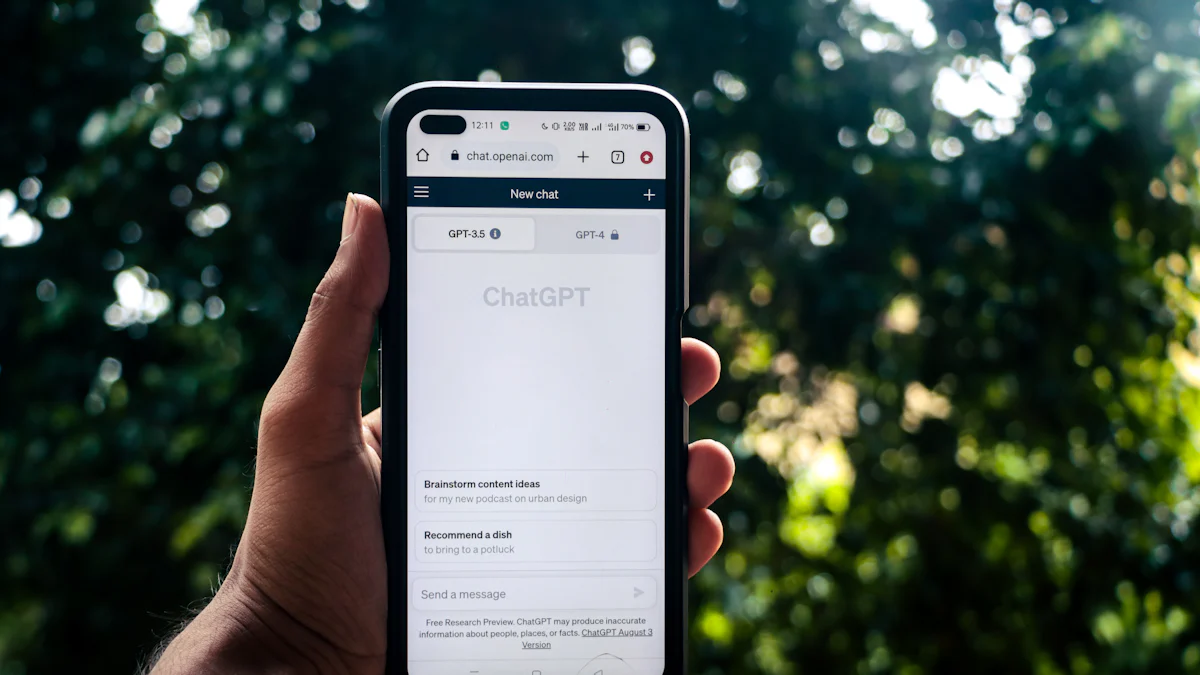Chat with Your Data: A Comprehensive Guide to Training ChatGPT with Custom AI Chatbot

Unlocking the Potential of Chat with Your Data
In today's digital landscape, the power of conversational AI is undeniable. With advancements in natural language processing and machine learning, chatbots have become an integral part of various industries, from customer support to virtual assistants. However, to truly unlock the potential of chatbots, it is essential to train them with relevant and personalized data.
By training ChatGPT with your own data, you can create a custom AI chatbot that understands and responds to user queries based on your specific domain or use case. This approach offers several benefits over using pre-trained models alone.
Firstly, training ChatGPT with your data allows for greater control and customization. You can tailor the chatbot's responses to align with your brand voice and provide accurate information specific to your industry. This level of personalization enhances user experience and builds trust with your audience.
Secondly, interacting with your data enables the chatbot to understand context better. By incorporating real-world examples and scenarios into the training process, you can improve the chatbot's ability to handle complex queries and provide more relevant responses.
To embark on this journey of training ChatGPT with your data, you need to prepare and format it appropriately for effective training. Cleaning and preprocessing the data are crucial steps that ensure its quality and relevance during training. Additionally, exploring integration options like the Chat Bubble Data API can further enhance the training process by providing access to a vast repository of conversational data.
The Chat Bubble Data API acts as a bridge between your custom dataset and ChatGPT's training pipeline. It allows you to leverage existing conversational data from various sources while augmenting it with your unique dataset. By combining these resources, you can create a robust training set that covers a wide range of user interactions.
In summary, by unlocking the potential of chat with your data, you gain control over customization, improve contextual understanding, and enhance user experience. In the following sections, we will delve deeper into preparing and formatting your data for training while exploring how the integration of the Chat Bubble Data API can further enrich your chatbot's capabilities.
Preparing and Formatting Your Data
Data preparation is a crucial step in training ChatGPT with your own data. Properly cleaned and preprocessed data ensures the accuracy and effectiveness of the chatbot's responses. Let's explore the importance of data preparation and the steps involved in formatting your data for training.
Importance of Data Preparation
Data preparation plays a vital role in training ChatGPT to deliver accurate and relevant responses. By cleaning and preprocessing your data, you remove noise, inconsistencies, and irrelevant information that can hinder the chatbot's performance.
One key aspect of data preparation is ensuring the quality of your dataset. This involves removing duplicate entries, correcting any errors or typos, and verifying the accuracy of the information provided. By maintaining a high-quality dataset, you can improve the reliability of your chatbot's responses.
Another critical consideration is handling sensitive or confidential information within your dataset. It is essential to anonymize or remove any personally identifiable information (PII) to protect user privacy and comply with data protection regulations.
To clean and preprocess your data effectively, follow these steps:
Data Cleaning: Remove irrelevant characters, symbols, or special characters that may interfere with natural language processing algorithms. Additionally, eliminate any outliers or anomalies that could impact the training process.
Text Normalization: Standardize text by converting it to lowercase, removing punctuation marks, expanding contractions (e.g., "don't" to "do not"), and handling abbreviations or acronyms consistently.
Tokenization: Split sentences into individual words or tokens to facilitate language understanding during training. Tokenization helps ChatGPT analyze text at a more granular level.
Formatting Data for Training
Formatting your data correctly is essential for optimizing training performance. Consider the following aspects when preparing your data:
Choosing the Right Format: Select a format compatible with ChatGPT's training pipeline. Common formats include plain text files (.txt), JSON files (.json), or CSV files (.csv). Ensure that each conversation is appropriately structured within these formats.
Structuring Conversations: Organize conversations into dialogue-based structures where each conversation consists of alternating user inputs and corresponding bot responses. This structure helps train ChatGPT to generate coherent replies based on user queries effectively.
By investing time in proper data preparation and formatting techniques, you lay a solid foundation for training ChatGPT with your own data effectively. In the next section, we will explore how integrating the Chat Bubble Data API can further enhance your chatbot's capabilities by leveraging an AI chatbot repository as a valuable knowledge base.
Utilizing the Chat Bubble Data API
The Chat Bubble Data API is a powerful tool that can greatly enhance your training process when working with ChatGPT. Let's explore what the Chat Bubble Data API is, its benefits, and how to implement it into your training workflow.
Introduction to Chat Bubble Data API
The Chat Bubble Data API provides access to an extensive AI chatbot repository, allowing you to leverage existing conversational data for training your custom chatbot. This repository serves as a valuable knowledge base that can augment your own dataset, providing a broader range of examples and scenarios for your chatbot to learn from.
By integrating the Chat Bubble Data API into your training pipeline, you gain access to a vast collection of conversations covering various topics and domains. This enables your chatbot to handle a wider range of user queries effectively and generate more accurate responses.
Benefits of integrating the API into ChatGPT training
Integrating the Chat Bubble Data API offers several key benefits:
Expanded Training Dataset: By combining your personal data with the AI chatbot repository, you significantly increase the diversity and coverage of conversations available for training. This leads to a more robust and comprehensive understanding of user queries.
Improved Response Quality: The additional training data from the AI chatbot repository helps refine the language model's ability to generate coherent and contextually relevant responses. It enhances the overall quality of responses provided by your custom chatbot.
Implementing the Chat Bubble Data API
To implement the Chat Bubble Data API into your training process, follow these steps:
API Integration: Begin by signing up for an account on the platform offering the Chat Bubble Data API. Once registered, obtain an API key that allows you to access their database programmatically.
Data Retrieval: Use appropriate methods provided by the platform's documentation to retrieve conversations from their database based on specific criteria or topics relevant to your use case.
Data Combination: Merge this retrieved data with your own dataset in a structured format suitable for training with ChatGPT. Ensure that conversations are organized in alternating user input and bot response format.
Training Pipeline Integration: Incorporate this combined dataset into your existing training pipeline alongside any preprocessing steps required for formatting consistency.
By utilizing the power of the Chat Bubble Data API, you can enrich your custom chatbot's training process with diverse conversational data from an AI chatbot repository. This integration expands its capabilities and improves response quality, ultimately enhancing user experience.
Training Techniques and Strategies
Training ChatGPT with your own data requires careful consideration of various techniques and strategies to achieve optimal results. Let's explore some effective training approaches as well as the concept of fine-tuning and iterative training for continuous improvement.
Effective Training Approaches
When it comes to training your custom chatbot, choosing the right training data size is crucial. While a larger dataset can provide more examples for the model to learn from, it also requires more computational resources and time for training. Finding the right balance is essential to avoid overfitting or underfitting the model.
Another effective approach is implementing transfer learning. Transfer learning allows you to leverage pre-trained models that have been trained on vast amounts of general language data. By starting with a pre-trained model and fine-tuning it using your specific dataset, you can benefit from the knowledge already acquired by the base model while tailoring it to your domain or use case. This approach can significantly improve performance and reduce training time.
Fine-tuning and Iterative Training
Fine-tuning is a technique that involves further refining a pre-trained language model using domain-specific or user-specific data. After initial training with your dataset, you can fine-tune the model by exposing it to additional conversations or queries relevant to your chatbot's purpose. Fine-tuning helps adapt the model's understanding and response generation capabilities specifically for your target audience.
Iterative training goes hand in hand with fine-tuning, allowing you to continuously improve your chatbot's performance over time. As you gather more user interactions and feedback, you can incorporate this new data into your training pipeline periodically. This iterative process helps refine the chatbot's responses based on real-world usage scenarios, ensuring its relevance and accuracy in addressing user queries.
By combining effective training approaches such as choosing an appropriate dataset size and implementing transfer learning, along with fine-tuning and iterative training techniques, you can train ChatGPT to become a highly capable conversational AI.
Generating Responses and Evaluating Performance
Once you have trained your custom chatbot with ChatGPT using your own data, it's essential to focus on generating high-quality responses and evaluating the performance of your chatbot. Let's explore different techniques for generating chatbot responses and the metrics used to assess their performance.
Response Generation Techniques
Generating responses that are coherent, relevant, and contextually appropriate is a key aspect of building an effective chatbot. There are several methods you can explore to improve the quality of generated responses:
Rule-based Approaches: Rule-based approaches involve defining a set of predefined rules or templates for generating responses based on specific patterns or keywords in user queries. While these approaches provide control over response generation, they may lack flexibility in handling complex or nuanced conversations.
Retrieval-based Approaches: Retrieval-based approaches involve retrieving pre-existing responses from a knowledge base or database of predefined answers. By leveraging an AI chatbot repository or a chatbot knowledge base, you can retrieve relevant responses based on similarity measures or keyword matching.
Generative Approaches: Generative approaches involve training language models like ChatGPT to generate responses from scratch based on the input received. These models learn from large amounts of text data and can produce more diverse and contextually appropriate responses. However, ensuring coherence and relevance can be challenging with this approach.
Performance Evaluation Metrics
Evaluating the performance of your chatbot is crucial to ensure its effectiveness in providing accurate and helpful responses. Here are some key metrics commonly used for assessing chatbot performance:
Response Coherence: Coherence measures how well the generated response aligns with the user's query or input. It evaluates whether the response makes logical sense within the conversation context.
Response Relevance: Relevance measures how closely the generated response matches the user's intent or query. It assesses whether the response addresses the user's needs effectively.
Engagement Level: Engagement level measures how well the chatbot keeps users engaged during conversations. It evaluates factors such as response length, conversational flow, and overall user satisfaction.
To obtain accurate assessment results, human evaluation is often employed alongside automated metrics. Human evaluators review sample interactions between users and the chatbot, rating factors such as response quality, clarity, and usefulness.
By focusing on generating high-quality responses using various techniques and evaluating performance through relevant metrics, you can continuously improve your custom chatbot's conversational capabilities.
Deployment and Future Developments
Once you have trained your custom chatbot using ChatGPT with your own data, it's time to consider the deployment of your chatbot in real-world scenarios. Additionally, staying updated with emerging trends and future developments in chatbot training is crucial to ensure the continued success of your AI-powered chatbot.
Real-world Deployment Considerations
When deploying your chatbot, there are several factors to consider:
Integration with Existing Systems: Evaluate how your chatbot will integrate with existing systems and platforms within your organization. This may involve integrating with customer support software, messaging platforms, or other communication channels.
Scalability and Performance: Assess the scalability and performance requirements of your chatbot. Ensure that it can handle increasing user demand without compromising response times or overall user experience.
User Feedback and Iterative Improvement: Implement mechanisms to gather user feedback on the performance of your chatbot in real-world scenarios. This feedback can help identify areas for improvement and guide iterative training processes.
Emerging Trends and Future Developments
The field of chatbot training is continuously evolving, with advancements in techniques and technologies shaping the future of AI-powered chatbots. Stay informed about these developments to keep your custom chatbot at the forefront:
Advancements in Chatbot Training Techniques: Researchers are constantly exploring new methods for training chatbots more effectively. These include approaches such as reinforcement learning, self-supervised learning, and multi-modal learning that incorporate additional modalities like images or videos into the training process.
The Future of AI-powered Chatbots: As natural language processing models continue to improve, we can expect AI-powered chatbots to become even more sophisticated. They will be capable of understanding complex queries, engaging in more human-like conversations, and providing personalized experiences tailored to individual users.
By considering real-world deployment considerations and staying updated with emerging trends in chatbot training, you can ensure that your custom AI-powered chatbot remains effective and relevant in an ever-evolving landscape.
Realizing the Power of Chat with Your Data
Training ChatGPT with your own data unlocks a world of possibilities and empowers you to create AI chatbots that can interact and converse with users in a more personalized and effective manner. Let's explore how harnessing the power of training ChatGPT with your data can unlock new possibilities for AI chatbots.
Unleashing the Potential of ChatGPT
By training ChatGPT with your own data, you tap into the unique knowledge and insights specific to your domain or use case. This allows your chatbot to provide more accurate and tailored responses to user queries. The ability to interact with your data enables the chatbot to understand context better, handle complex questions, and deliver relevant information.
Moreover, by incorporating real-world examples from your dataset, you enhance the chatbot's conversational abilities. It becomes capable of addressing specific industry-related challenges, understanding domain-specific terminology, and adapting its responses accordingly. This level of personalization creates a more engaging user experience while building trust and credibility.
Unlocking New Possibilities for AI Chatbots
Training ChatGPT with your data opens up new avenues for AI chatbots across various industries:
Customer Support: AI-powered chatbots trained on customer support data can provide instant assistance, answer frequently asked questions, and guide users through troubleshooting processes.
Virtual Assistants: Personalized virtual assistants can be created by training ChatGPT on individual preferences, calendars, or specific tasks. These assistants can help manage schedules, set reminders, or even perform simple tasks like ordering food.
Education: Customized educational chatbots can be developed by training ChatGPT on relevant learning materials. These chatbots can provide interactive lessons, answer student queries, or offer personalized study recommendations.
Healthcare: By training ChatGPT on medical literature or patient records (while maintaining privacy), healthcare chatbots can assist in symptom assessment, provide basic medical advice, or offer information about medications.
The potential applications are vast across numerous industries where personalized interactions and accurate information delivery are crucial.
NewOaks AI Builds Chatbot with Your Data Through API and Webhook
Deploying a custom AI chatbot trained with your own data is made possible through the integration of the Chat Bubble Data API and webhook capabilities. This combination allows you to explore the full potential of ChatGPT in real-world applications while staying updated with future developments in chatbot training.
By leveraging the Chat Bubble Data API, you can access an extensive AI chatbot repository that enriches your training dataset. This repository acts as a valuable knowledge base, providing a wide range of conversational data to enhance your chatbot's understanding and response generation capabilities. Integrating this data with your own dataset creates a powerful training set that covers diverse user interactions.
Through the use of webhooks, you can seamlessly connect your custom AI chatbot to various platforms and systems. This enables you to deploy your chatbot across different channels such as websites, messaging apps, or voice assistants. By integrating with existing systems, you can provide users with convenient access to your chatbot while ensuring a consistent experience across multiple touchpoints.
As you deploy your custom AI chatbot trained with your own data, it's important to continuously monitor its performance and gather user feedback. This feedback helps identify areas for improvement and guides iterative training processes to enhance the accuracy and relevance of responses.
Staying updated with future developments in chatbot training is crucial for keeping your AI-powered chatbot at the forefront of technological advancements. As new techniques emerge and natural language processing models evolve, embracing these developments will enable you to further enhance the capabilities of your chatbot and deliver even more personalized experiences to users.
In conclusion, by utilizing the Chat Bubble Data API, integrating webhooks for deployment, and staying informed about advancements in chatbot training, NewOaks AI empowers you to build a powerful custom AI chatbot that interacts and converses effectively using your own data.
See Also
A Comprehensive Guide: Training ChatGPT Using Your Own Data
Optimize Sales Funnel with AI Chatbots: A Detailed Walkthrough
In-Depth Tutorial: Building a Custom ChatGPT Chatbot for Business
Constructing a ChatBot Using ChatGPT and Zapier: A Detailed Tutorial
A Comprehensive Handbook: Exploring Intercom's Fin AI Chatbot

